Comparison
Comparison Between Sony OLED and LG OLED. Which Is Better?

Some benefits of OLED displays are deeper blacks, no color leakage, wide viewing angles, and reduced battery consumption. The QLED market is dominated by Samsung, whereas the OLED market is led by Sony and LG.
Each company offers excellent OLED Televisions to hold its own against the competition. It turns out that there is no obvious victor when comparing premium OLED televisions; instead, your choice will largely depend on the specific models you look at.
Overall, LG is the best option for video games, while Sony is the best choice for home theatre. If you want to know the specifics of the differences between Sony OLED and LG OLED, read our comparison!
Comparison Between Sony OLED and LG OLED

Regarding OLED technology, Sony was the first to market with their 2007 creation of the Sony XEL-1. Sony has now developed an extensive line of OLED TVs in various sizes, all of which use LG Display’s proprietary OLED display.
When it comes to sound quality, Sony is unrivaled, and the company also provides impressively brilliant maximum illumination.
Sharp OLED Professionals from Sony
Improvements in scaling and motion technologies
Brighter and more colorful peak output Google TV, which uses the Android operating system and is thus more familiar to most users
Pros:
- Crisp, clear audio;
- Built-in speakers;
- No external speakers to worry about
Cons:
- There are fewer HDMI 2.1 ports than LG’s competitive products.
- Reduced reaction times.
Currently, LG is the only company producing OLED panel technology. OLED patent holder and panel supplier LG Display
also works with household names, including Hisense, Panasonic, Philips, and Sony. Regarding dimming and viewing angles, LG’s OLED Televisions are unrivaled.
LG’s OLED Display
Pros:
- Fantastic black depths and shading
- More HDMI 2.1 ports are available.
- Several entry-level and midrange models are less expensive than Sony.
- Improved low-delay input.
Cons:
- Many models need help generating adequate light, particularly during the day.
- The sound quality is inferior to Sony’s and won’t transport you to the theatre.
The Use of Panel Technology

The functionality of Sony’s OLED panels should be almost identical to LG Display’s since Sony purchases its panels from LG Display. Every pixel in an OLED display produces its light source. The end effect is improved contrast, darker blacks, and lower power consumption.
The lack of an LED backlight in OLED Televisions makes it more challenging for them to compete with the brightness of LED or QLED TVs, particularly in well-lit areas.
The newest devices from Sony and LG, which use the same LG-made OLED Evo screen, have fixed these problems.
Analyzer of images
Sony puts a lot of emphasis on the superiority of their X1TM Extreme processor in their advertising, and with good cause. It’s cutting-edge software that employs algorithms to reduce background noise for improved clarity, sharper contrast, and richer tonal range.
On the other hand, LG’s most recent OLED Televisions have nine Gen4 AI processors. Its processor can detect the kind of media you’re watching and the room’s lighting conditions to adjust the display parameters accordingly.
Sony excels in this area by providing pixel-level brightness boosting, a higher color quality, and object-based image processing, in addition to the excellent color accuracy and image processing offered by both firms. Sony OLED TVs often also have superior HDR performance compared to comparable LG OLED products.
The Science of Motion
LG’s motion processing technology now features a new option this year dubbed Cinematic Movement. In other words, because most films are shot at 24 frames per second, this setting is ideal for enhancing the cinematic experience.
It’s possible that Sony’s impressive showing in the home theatre market inspired this development.
Sony’s newest televisions, such as the A90J, provide excellent motion processing and a crisp, realistic picture.
Sony’s Motion TV Tech
Most Sony OLED models exceed LG’s competitive models when it comes to motion processing.
Display Resolution
We need to break down the topic of image quality into multiple subtopics since there is much to cover.
https://www.sony.ee/electronics/televisions/af9-series
Ratio of contrast
In most cases, the contrast ratio difference between a Sony and LG OLED TV will be imperceptible to the human eye.
As OLED represents the pinnacle of TV performance, almost every model from both brands boasts superb contrast and dark levels.
Looking at individual models in a range of sizes and prices will provide additional options.
- Optic Disc Replica (XR) from Sony:
High Contrast
Yet, Sony is widely acknowledged to have superior contrast and purer and sharper whites.
Discreet dimming
LG has the upper hand when it comes to local dimming. When comparing two Televisions in a similar price range, you’ll likely find that LG’s superior dimming technology gives you greater subtlety in the dark range. To reiterate,
both Sony and LG OLED TVs will appear noticeably better in dark areas of games and movies than a standard LED TV. LG triumphs over Sony because it offers superior local dimming and deeper, nuanced blacks.
LG G1
Brightest point
The lack of brightness in OLED displays is already a problem. Brightness levels are drastically reduced due to the absence of an LED backlight, which is especially noticeable in viewing areas with a lot of natural light.
Sony and LG have made significant strides in this area and will have shipped stunning versions by 2023 that provide very high brightness levels. Sony’s A90J model includes an aluminum screen for the greatest available brightness in an OLED display.
As of now, Sony is the only manufacturer that provides brighter maximum settings. Both companies have significantly improved screen brightness, although older LG devices may still have trouble reading outside.
Expression in Color
There is little to no discernible difference between the two brands regarding color reproduction and performance.
On the other hand, Sony often seems more brilliant and colorful since it has greater peak brightness and better contrast overall. Sony’s OLED TVs often appear better than LG’s for scenic vistas in nature documentaries and science fiction flicks featuring magnificent settings.
Sony Bravia XR Trolamines Pro
When comparing Sony and LG, the color options available will vary depending on the specific model you’re considering.
High-Quality Sound
Slim and bendable as most OLED Televisions are, they don’t leave much room for impressive audio hardware. The sound quality of your TV is limited to whatever is built into it until you install extra speakers.
As with LG, it’s variant and series-specific. Dolby Atmos is included in many newer models, including the new G1, and provides a well-balanced, bass-heavy listening experience without the need for a soundbar. It’s all improved by AI Acoustic Tuning, which adapts sound to your space.
Sony’s Surface Acoustic Audio+
Sony goes above standard audio by including its Acoustic Surface Audio, which creates sound by vibrating the whole display. Sony’s use of audio tracking ensures that sounds emanate from the exact location on the screen where the activity is taking place.
Without a surround system or soundbar, the impact is still impressive. As far as audio goes, Sony is head and shoulders above the competition.
A platform for Smart TVs
Google TV, which is built on Android, is used by Sony. The Play Store is compatible with all OLED TVs and offers a wide selection of additional applications that complement the popular pre-installed ones.
The webOS platform is exclusive to LG Televisions. The user interface is intuitive and packed with useful tools. It also has some neat extra features like smart home integration and sports notifications that you may find useful.
Using LG’s Web OS
The fact that Sony OLED TVs have Chromecast built-in is one area in which they excel above-competing products using webOS. LG has screen-sharing features, but Chromecast users will find it much easier to cast from their mobile devices.
You can expect to find all of today’s most popular software on both platforms, and their user interfaces are comparable. Maybe Sony deserves a nod of approval due to the presence of built-in Chromecast support, but ultimately, your taste will determine which one you choose.
Connectivity
The first thing to remember is that LG has more HDMI 2.1 ports than any other brand, regardless of screen size or price range. Unlike Sony’s A90J, which only has two, LG’s G1 provides four 40gbps HDMI 2.1 ports.
As in other categories, LG excels with its remote controls. Common to most LG OLED TVs is a wand-like remote that may be used as a point-and-click interface à la Wii. This significantly improved Sony’s standard remote in navigating the menus.
Amazon Alexa and Google Assistant are among the many smart home technologies in LG’s smart TVs and are easily accessed with the included remote.
For gamers using next-gen consoles, LG provides superior connection possibilities. Thanks to its increased number of HDMI 2.1 connectors, LG is better equipped for the future.
Unique characteristics
Now that we’ve covered the basics let’s speak about the key distinctions between the two that make one brand a better choice.
LG provides superior gaming performance.
For many reasons, LG OLED Televisions are the superior option for playing video games. First and foremost, when comparing any two models from any manufacturer, LG provides a faster reaction time.
It’sDefendingy in a sector where latency reduction is a primary priority. An is difficult LG goes even further, including fantastic modes that boost performance no matter what you’re doing. The enhanced refresh rates and blur reduction of the Gaming mode are useful.
Also, having more HDMI 2.1 connections means you may connect your console, sound system, and other devices simultaneously without missing a beat.
Depe may be the superior option for your home theatre. So depending on your needs, audio quality and increased visibility in broad sunlight are two advantages to consider.
Having a Sony Stereo System on Your TV
Hence, if you’re searching for a device that can handle movies and other entertainment that doesn’t need fast reaction times or more than 24 frames per second, Sony’s lineup may be a better option. If you like watching movies and leaving the TV on all day but want to save money on something other than a speaker system, Sony is your best bet.
Price
Prices will vary from model to model and will depend heavily on the display size. Nonetheless, LG offers lower prices, particularly in the middle of the market. The base price of the LG CX OLED is roughly $1,499, while the base price of the Sony A8H OLED is $1,899.
LCD TV with OLED Technology by LG
In addition to providing more affordable options, LG provides more sizes and designs for its devices. Adding the 77-inch display to the same CX model may raise the price to $4,999. Sony’s A8H has a maximum screen size of 65 inches and costs $2,499.
Sony A8H Plasma TV
Television, Sony Bravia A8H
There is a vast selection of models and sizes, but LG generally has better pricing and greater variety.
https://www.smarthomelivinginsider.com/is-sonos-move-work-with-bluetooth/
Conclusion
Let’s get this out of the way before we wind up our Sony OLED vs. LG OLED comparison: you can’t go wrong with any OLED TV from these two companies. Whether upgrading from an LCD TV or an older OLED, you will be satisfied with a Sony or an LG OLED television.
Whatever you choose depends on your taste and how you want to put it to use. If you’re a film buff who wants to watch movies and TV episodes on a screen that offers the highest possible picture quality, go no further than Sony’s OLED televisions.
Some of the latest models have exceptional brightness levels, which are unusual for OLED displays, along with excellent audio quality, vivid colors, and deep blacks.
LG makes more sense for gamers because of its superior reaction times, connection, and gaming mode. Still, LG’s OLED TVs are pretty good for movie buffs, and if money is tight, it can make even more sense to go with LG.
-

 Solutions2 years ago
Solutions2 years agoHow to Connect Your Vizio TV to WiFi Easily Without a Remote?
-

 Solutions2 years ago
Solutions2 years agoWhy is My Samsung TV Picture So Dark? Exploring the Possible Causes
-

 Accessories2 years ago
Accessories2 years agoCan A Hdmi Splitter Extend The Display To 2 Monitors?
-

 Gadgets2 years ago
Gadgets2 years agoFitbit Symbols Meaning: What Do The Fitbit Icons Mean?
-

 Accessories2 years ago
Accessories2 years agoDo Smart Thermostats Run On Batteries? Let’s Find Out
-

 Solutions2 years ago
Solutions2 years agoWhy Can’t I Stream Netflix From My Phone? | Solution
-

 Solutions2 years ago
Solutions2 years ago8 Ways How To Stop Google Home Nest From Crackling
-

 Solutions2 years ago
Solutions2 years agoHow To Fix Charging Not Available? Iphone Liquid Detected




